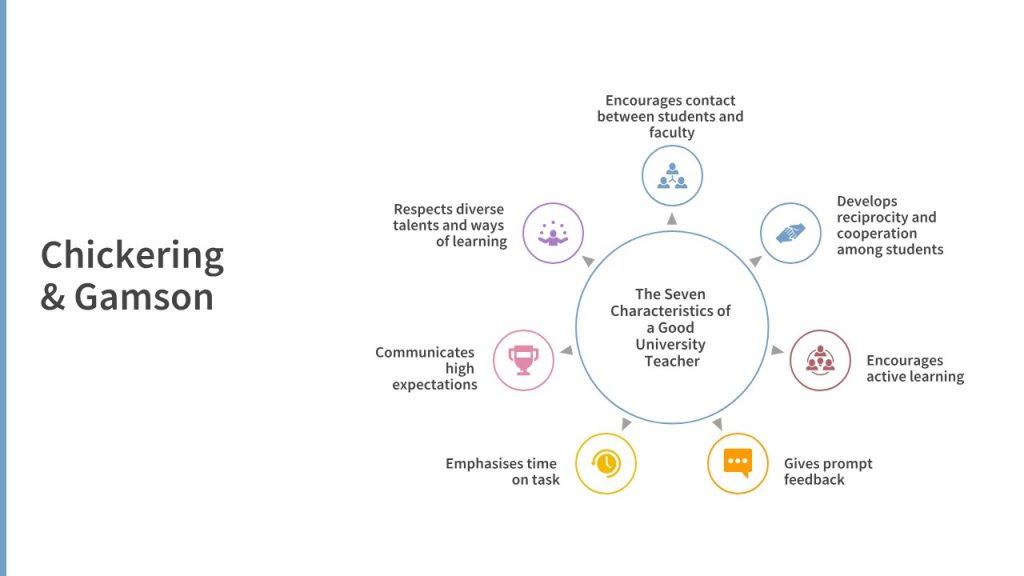On Wednesday 20th February, I attended “Respecting Diverse Talent and Ways of Learning: A Blended Approach”, the latest in a series of workshops organised by SALT on “The Seven Characteristics of a Good University Teacher” [1]. Inspired by the work of Arthur W. Chickering and Zelda F. Gamson [2], the workshops “aim to illustrate successful implementation of the principles (of the seven characteristics of good university teaching), providing inspiration and support for academic staff wishing to further develop learning and teaching in their area”.
The “7Cs” workshops provided me with my first experience of SALT and the work we undertake; I am indebted to them for providing examples of best practice and teaching excellence and for introducing me to academics and professionals from across the University. In addition to a nice cup of tea and a biscuit, there is always a buzz (the tell-tale sign of enthusiasm and cross-pollination of ideas rather than the kind associated with unpleasant smells) at a 7Cs workshop which always provides a much-needed mid-week boost.
The “Respecting Diverse Talent and Ways of Learning: A Blended Approach” workshop was facilitated by Melanie Hainke [2] and Eve Mortiarty [3] who have spent the last 12 months working on the Blended Learning Pilot which aims “to support academics to develop either a new module or re-develop an existing module with a blended learning approach, whilst enhancing the student experience and satisfaction, through access to online learning materials to supplement face-to-face delivery time”. Melanie’s focus was working with academics to develop new modules or adapt existing ones to promote blended learning whilst Eve was primarily responsible for embedding Virtual Reality solutions into appropriate modules.
Blended Learning: “a combination of face-to-face learning and dynamic digital activities and content that facilitate anytime/anyplace learning”, JISC
As with all 7Cs workshops, attendees had disparate exposure to and understanding of the topic (a fact which makes the discussions even more interesting), so, during the first part of the workshop, each table was invited to discuss what Blended Learning meant to them and share their conclusions with the rest of the room. Following this dialogue, Melanie stressed that the difference between the basic use of multimodal resources in teaching and truly blended learning was that the latter emphasised interactions and connections between online learning and face-to-face activities and resources. [4] In a nutshell, a blended approach makes learning more accessible, flexible, and, because it promotes the application of knowledge in wider variety of scenarios, more permanent.
In the second part of the workshop, attendees were asked to share how their own teaching either used blended learning or would benefit from it. Answers were provided for disciplines as diverse as Change Management, Geography and Egyptology and for specific teaching challenges such as addressing the diverse needs of international students. Some of the topics discussed included the perception of blended learning in traditionally conservative subjects and the need to constantly evaluate changing patterns in how students learn, adapting resources and methods as required.
During the final part of the workshop, attendees were invited to watch and reflect on a series of videos that had been produced for the Blended Learning Pilot. Each video (Emphasising Time on Task: Neal Harman [Science], Develops reciprocity and cooperation among students: Peter Dorrington and Will Harrison [Engineering], Encourages active learning: Richard Leonard-Davies [Law]) was selected to highlight a 7Cs facet and included an interview with academics who explained the rationale behind redesigning their modules, the processes involved and the observed outcomes. The videos were used to demonstrate that diverse talent and ways of learning can be respected using:
- Powerful visuals
- Well-organised print/digital resource
- Direct, vicarious and virtual experiences
- Tasks that require analysis, synthesis and evaluation
- Applications to real life situations
- Self-reflection and self-evaluation
- Collaboration and group problem solving
Given the extensive use of technology and innovative software solutions in the Blended Learning Pilot, attendees were keen to learn about the resources available to them and expressed the desire for the provision of training to be made more widely available.
As with every 7Cs workshop, the final whistle came around too quickly and many participants had to dash back to their offices or lecture rooms, hopefully with a commitment to “change one thing”. Invariably, those that do not have any commitments stay behind to continue the discussion, so Melanie and Eve went into extra-time, answering further questions on their work and giving advice on how to best introduce Blended Learning into existing modules.
[1] https://spark.adobe.com/page/vUuxhmKq2iJkz/
[2] https://files.eric.ed.gov/fulltext/ED282491.pdf
[3] melanie-jayne.hainke@swansea.ac.uk, https://twitter.com/melcurds
[4] e.e.moriarty@swansea.ac.uk
[5] https://twitter.com/mandyjjack/status/1098213474419777536



